
Gannets are seabirds comprising the genus Morus, in the family Sulidae, closely related to boobies. "Gannet" is derived from Old English ganot, ultimately from the same Old Germanic root as "gander". Morus is derived from Ancient Greek moros, "foolish", due to the lack of fear shown by breeding gannets and boobies, allowing them to be easily killed.

A booby is a seabird in the genus Sula, part of the family Sulidae. Boobies are closely related to the gannets (Morus), which were formerly included in Sula.
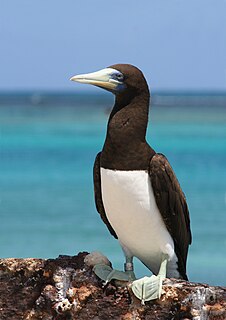
The bird family Sulidae comprises the gannets and boobies. Collectively called sulids, they are medium-large coastal seabirds that plunge-dive for fish and similar prey. The 10 species in this family are often considered congeneric in older sources, placing all in the genus Sula. However, Sula and Morus (gannets) can be readily distinguished by morphological, behavioral, and DNA sequence characters. Abbott's booby (Papasula) is given its own genus, as it stands apart from both in these respects. It appears to be a distinct and ancient lineage, maybe closer to the gannets than to the true boobies.

The northern gannet is a seabird, the largest species of the gannet family, Sulidae. It is native to the coasts of the Atlantic Ocean, breeding in Western Europe and Northeastern North America. The sexes are similar in appearance. The adult northern gannet has a mainly white streamlined body with a long neck, long and slender wings. It is 87–100 cm (34–39 in) long with a 170–180 cm (67–71 in) wingspan. The head and nape have a buff tinge that is more prominent in breeding season, and the wings are edged with dark brown-black feathers. The long pointed bill is blue-grey, contrasting with black bare skin around the mouth and eyes. Juveniles are mostly grey-brown, becoming increasingly white in the five years it takes them to reach maturity.

The Australasian gannet, also known as the Australian gannet or tākapu, is a large seabird of the booby and gannet family, Sulidae. Adults are mostly white, with black flight feathers at the wingtips and lining the trailing edge of the wing. The central tail feathers are also black. The head is tinged buff-yellow, with a pale blue-grey bill edged in black, and blue-rimmed eyes. Young birds have mottled plumage in their first year, dark above and light below. The head is an intermediate mottled grey, with a dark bill. The birds gradually acquire more white in subsequent seasons until they reach maturity after five years.

The brown booby is a large seabird of the booby family, Sulidae, of which it is perhaps the most common and widespread species. It has a pantropical range, which overlaps with that of other booby species. The gregarious brown booby commutes and forages at low height over inshore waters. Flocks plunge-dive to take small fish, especially when these are driven near the surface by their predators. They only nest on the ground, and roost on solid objects rather than the water surface.
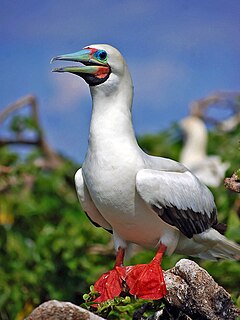
The red-footed booby is a large seabird of the booby family, Sulidae. Adults always have red feet, but the colour of the plumage varies. They are powerful and agile fliers, but they are clumsy in takeoffs and landings. They are found widely in the tropics, and breed colonially in coastal regions, especially islands. The species faces few natural or man-made threats, although its population is declining; it is considered to be a least-concern species by the International Union for Conservation of Nature (IUCN).

The Cape gannet originally Sula capensis, is a large seabird of the gannet family, Sulidae.
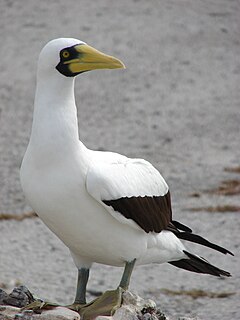
The masked booby, also called the masked gannet or the blue-faced booby, is a large seabird of the booby and gannet family, Sulidae. First described by the French naturalist René-PrimevèSula. It has a typical sulid body shape, with a long pointed yellowish bill, long neck, aerodynamic body, long slender wings and pointed tail. The adult is bright white with black wings, a black tail and a dark face mask; at 75–85 cm (30–33 in) long, it is the largest species of booby. The sexes have similar plumage. This species ranges across tropical oceans, except in the eastern Atlantic and eastern Pacific. In the latter, it is replaced by the Nazca booby, which was formerly regarded as a subspecies of masked booby.
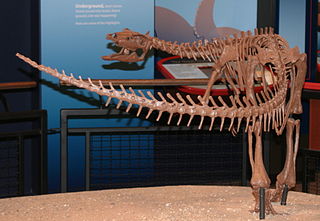
Thescelosaurus was a genus of small ornithopod dinosaur that appeared at the very end of the Late Cretaceous period in North America. It was a member of the last dinosaurian fauna before the Cretaceous–Paleogene extinction event around 66 million years ago. The preservation and completeness of many of its specimens indicate that it may have preferred to live near streams.

The Nazca booby is a large seabird of the booby family, Sulidae, native to the eastern Pacific. First described by Walter Rothschild in 1902, it was long considered a subspecies of the masked booby until recognised as distinct genetically and behaviorally in 2002. It has a typical sulid body shape, with a long pointed orange-yellow bill, long neck, aerodynamic body, long slender wings and pointed tail. The adult is bright white with black and white wings, a black tail and a dark face mask.

Revueltosaurus is an extinct genus of suchian pseudosuchian from Late Triassic deposits of New Mexico, Arizona and North Carolina, United States. Many specimens, mostly teeth, have been assigned to Revueltosaurus over the years. Currently, three species are included in this genus, all of which were originally thought to represent monospecific genera of basal ornithischian dinosaurs. It was 1 meter long.
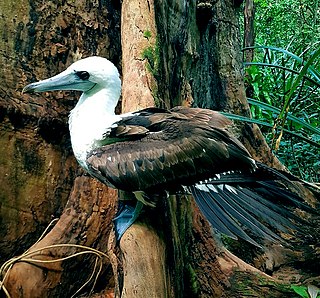
Abbott's booby is an endangered seabird of the sulid family, which includes gannets and boobies. It is a large booby, smaller than gannets, and is placed within its own monotypic genus. It was first identified from a specimen collected by William Louis Abbott, who discovered it on Assumption Island in 1892.
Bruce R. Erickson is an American paleontologist and the former Fitzpatrick Chair of Paleontology at the Science Museum of Minnesota. During the course of his lifetime and his 55 years as a paleontologist, he has "collected about a million specimens" and discovered fifteen new types of plants and ancient animal species. His collection includes "a triceratops skeleton" that he discovered in 1961 at the Hell Creek Formation that is considered to be "one of the rarest in the world". His research has focused almost entirely on the Paleocene era in history.

The order Suliformes is an order recognised by the International Ornithologist's Union. In regard to the recent evidence that the traditional Pelecaniformes is polyphyletic, it has been suggested that the group be split up to reflect the true evolutionary relationships.

Galeamopus is a genus of herbivorous diplodocid sauropod dinosaurs. It contains two known species: Galeamopus hayi, known from the Late Jurassic lower Morrison Formation of Wyoming, United States, and Galeamopus pabsti, known from the Late Jurassic fossils from Wyoming and Colorado. The type species is known from one of the most well preserved diplodocid fossils, a nearly complete skeleton with associated skull.
Joseph Bryan Nelson MBE FRSE was a British ornithologist, environmental activist and academic. He was a prominent authority on seabirds, publishing numerous books and articles on gannets, cormorants and other species, teaching zoology at the University of Aberdeen, and conducting pioneering ornithological research in Jordan, Christmas Island and the Galápagos Islands. In his lifetime, Nelson was "acclaimed as the world's leading expert on the northern gannet". He also contributed to the creation of Christmas Island National Park, which helped to preserve the habitat of the endangered Abbott's booby.

Eogranivora is a bird genus, belonging to the Ornithuromorpha, that lived in the area of present-day China during the Early Cretaceous. Its type species is Eogranivora edentulata.
Rhamphastosula is an extinct genus of sulid bird known from fossils discovered in early Pliocene rocks of Peru. The type and only named species is R. ramirezi, named for Peruvian vertebrate paleontologist Gregorio Ramirez. The genus name is a combination of "Rhamphastos", "toucan" and "sula", an Icelandic word for "fool" that has been used to describe boobies in general.















